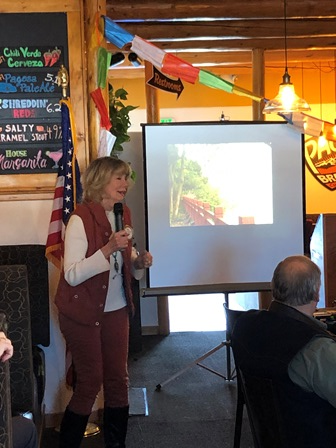
Speaker: Kim (Globetrotter) Moore, on her trip to Tibet.
Nowhere, apparently, is there a corner of the globe where Kim Moore’s curiosity is outpaced by “cost, germs or fuss,” or perhaps anything else, other than possibly war (I don’t think she’s been to Afghanistan, but there are negotiations underway to end that conflict, so maybe that’s next year). The “hugging diplomat” gets more use out of a passport than anyone other than possibly airline pilots!
(Plus, Kim is not flustered by technological glitches. When the balky slide projector showed images on end last Thursday, “tilt your head,” she suggested unflappably to the audience.)
Kim explained that her trip to Tibet was an offshoot of a Tibetan water project organized under the auspices of Rotary International by Durango Rotary. A group from the Durango club went to visit the project site, and Kim seized the opportunity to join up with them for the trip.
Nowhere, apparently, is there a corner of the globe where Kim Moore’s curiosity is outpaced by “cost, germs or fuss,” or perhaps anything else, other than possibly war (I don’t think she’s been to Afghanistan, but there are negotiations underway to end that conflict, so maybe that’s next year). The “hugging diplomat” gets more use out of a passport than anyone other than possibly airline pilots!
(Plus, Kim is not flustered by technological glitches. When the balky slide projector showed images on end last Thursday, “tilt your head,” she suggested unflappably to the audience.)
Kim explained that her trip to Tibet was an offshoot of a Tibetan water project organized under the auspices of Rotary International by Durango Rotary. A group from the Durango club went to visit the project site, and Kim seized the opportunity to join up with them for the trip.
Tibet sits on the northern slope of the Himalayas. Mt. Everest rests astride its border with Nepal. It’s capital, Lhasa, is at 8000 feet, and much of the country’s altitude is even higher – according to Wikipedia, its average elevation is 16,000 feet. A Tibetan Empire existed in the 6th Century, but today Tibet is politically an autonomous region of China. It was absorbed by the Chinese after an invasion mounted in the 1950’s, Kim said.
The travelers’ jumping off point for entry to the small, mountainous country was Chengdu, China, where the group boarded a train for the 23-hour trip. They had time beforehand, however, to visit the Center for Preservation of Pandas in Chengdu; the city evidently sits in the midst of the exotic animals’ range.
According to Kim, Tibet’s population numbers between four to five million, mostly farmers or nomads. She reported its citizens are subject to substantial repression by their Chinese overlords, and substantial restrictions are imposed on Tibetans’ civil freedom, including mandatory displays of fealty to Chinese leaders.
Tibet was formerly the home of the Dalai Lama, a political and religious leader banished by the Chinese, well-known today throughout the world as a humanistic and ethical holy person. But today his home, a building of more than 1000 rooms in Lhasa known as the Portola, is a tourist attraction.
But religion is nonetheless freely practiced. Tibetans, Kim reported, are primarily devout Buddhists. The country is home to 4700 monasteries, and statues of Buddha in all sizes, shapes, expressions and appearances are ubiquitous. The large population of monks shave their heads, Kim told us, to avoid dwelling on appearance and keep their lives simple. (Dave Richardson spontaneously endorsed the wisdom of their choice.)
In addition to monasteries, substantial public displays of “prayer flags,” are common throughout Tibet, with elaborate formations of flags in shapes like large pin-wheels or bulls-eyes set-up by monks on mountainsides. And pilgrims are a frequent sight at monasteries, Kim reported, rotating “prayer-wheels” in pursuit of inner peace as they circle the structures on foot.
Yaks, appearing similar to large, shaggy-coated goats, are everywhere in Tibet, and are frequently seen grazing even at high altitude in the mountains. Tibetan culture revolves around the animal, Kim said. Yak meat is a common food, and yak dung is a common fuel.
Another common food is a bread-like loaf called Sampa, made out of barley flour. For a beverage, Kim extolled the lemon-ginger-honey tea she was served.
Kim and others in her group visited a Mt. Everest base camp, at 18,000 feet altitude. The route to the camp was a tortuous ascent up a road of endless switchbacks over three mountain passes. Great motorcycling, it appeared, except Kim reported the conditions were cold and windy. She rented a Chinese Army parka for use in the daytime, and used five quilts to keep warm at night.
What about bathrooms, Kim was asked. Squatters only, she recalled for the most part, except in handicap facilities. Ever adaptable, Kim made the obvious choice for comfort, when possible.
Kim also reported that street vendors plying the trade of ear-cleaning, are common in Tibet. She recommended the practice to all, as It clarifies your brain (or so she claimed).
And yes, Kim reported, there was at least one long and heartfelt hug shared along the way. Never fear, the hugging diplomat is always ready!
In addition to monasteries, substantial public displays of “prayer flags,” are common throughout Tibet, with elaborate formations of flags in shapes like large pin-wheels or bulls-eyes set-up by monks on mountainsides. And pilgrims are a frequent sight at monasteries, Kim reported, rotating “prayer-wheels” in pursuit of inner peace as they circle the structures on foot.
Yaks, appearing similar to large, shaggy-coated goats, are everywhere in Tibet, and are frequently seen grazing even at high altitude in the mountains. Tibetan culture revolves around the animal, Kim said. Yak meat is a common food, and yak dung is a common fuel.
Another common food is a bread-like loaf called Sampa, made out of barley flour. For a beverage, Kim extolled the lemon-ginger-honey tea she was served.
Kim and others in her group visited a Mt. Everest base camp, at 18,000 feet altitude. The route to the camp was a tortuous ascent up a road of endless switchbacks over three mountain passes. Great motorcycling, it appeared, except Kim reported the conditions were cold and windy. She rented a Chinese Army parka for use in the daytime, and used five quilts to keep warm at night.
What about bathrooms, Kim was asked. Squatters only, she recalled for the most part, except in handicap facilities. Ever adaptable, Kim made the obvious choice for comfort, when possible.
Kim also reported that street vendors plying the trade of ear-cleaning, are common in Tibet. She recommended the practice to all, as It clarifies your brain (or so she claimed).
And yes, Kim reported, there was at least one long and heartfelt hug shared along the way. Never fear, the hugging diplomat is always ready!
 Pagosa Springs Rotary Club
Pagosa Springs Rotary Club